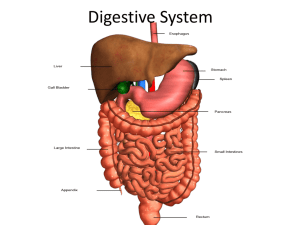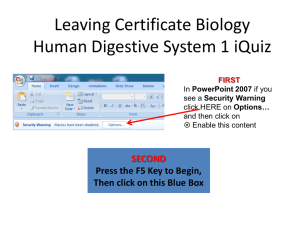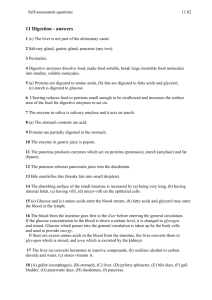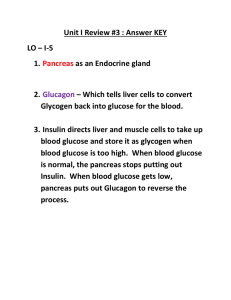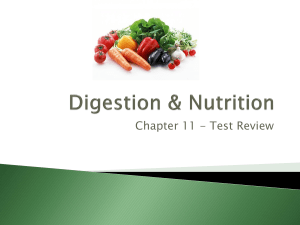HOW YOU DIGEST FOOD
advertisement
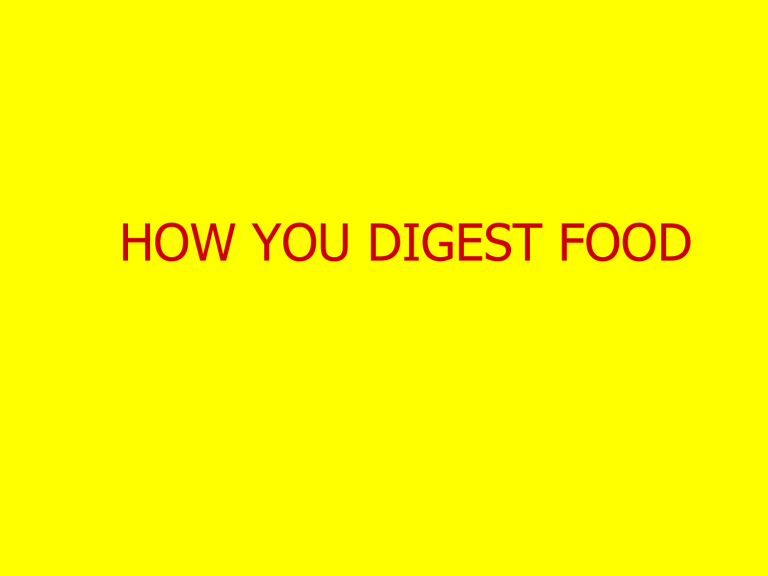
HOW YOU DIGEST FOOD DIGESTION: Breakdown of food Small components WHY? • Carbohydrates Sugars • Protein Amino Acids • Fats Fatty Acids Absorption: Taking Substances Interior of Body (blood) Gastrointestinal Tract: 30 feet long Mouth Large Intestine Rectum Pharynx Small Intestine Esophagus Stomach Anus Transit time- Food: Mouth Anus 24-72 hours (small beads + meal) Digestion Begins: “Mouth Waters” Stomach Gastric Juice • Sight • Sounds • Smell Mouth- Salivary Glands Saliva Starch (bread) Enzymes (protein): speed up chemical reaction, reused. A enzyme B Substrate Enzyme Product(s) Saliva • Chemical Digestion • Mechanical Digestion: Chewing Surface Area- Digestive Juices Mouth Food Pharynx (throat) Esophagus Swallowing Epiglottis (trachea) breathing swallowing food Food Esophagus Stomach Sphincter Peristalsis • Vomiting • Heartburn • Gastroesophageal Reflux Disease (GERD) Backwash: stomach acid GERD: Possible causes • Overweight • Family history • Hiatal hernia • Smoking • Excessive alcohol • Large or high fat meals Obesity Surgery Gastric bypass, stapling, banding Digestion in Stomach 2-6 hours • Gastric Juice: Acid (kills bacteria) + Enzymes • Enzyme: Pepsin Protein digestion • Contractions: Churning, mixing food Release of Gastric Juice • Nervous system: thought, smell, taste- food brain gastric juice impulses stomach Release of Gastric Juice • Hormone: Gastrin Response to food in stomach: Gastric Juice Contractions Absorption (limited) in stomach • Water • Alcohol • Aspirin, Acetaminophen (Tylenol) Chyme (partially digested liquid food) sphincter small intestine (duodenum) • Large, solid meal- slower • Small, liquid meal-faster Stomach Emptying Carbohydrates Protein Sadness/Fear Aggression Fat Emptying Emptying + Contractions ULCERS • Stomach lining- gastric mucosa • Erosions (open sores) of liningesophagus, stomach, duodenum: peptic ulcer • 1 in 10 people ULCERS- Causes • Bacteria (Helicobacter pylori) • Aleve, Advil, Motrin (not Tylenol) • Smoking • Excess alcohol “An 11 year look inside the living stomach” • 1822- Fur trapper’s store Michigan. • Gun accident: St. Martin shot Dr. Beaumont dressed wound • Healing fistula gauze (opening) Dr. Beaumont and St. Martin Beaumont-St. Martin • Bread gastric juice release • Remove fluid test tube digest meat • Anger: gastric mucosa red (blood) contractions acid • Fear: gastric mucosa pale contractions Most digestion: small intestine 3-5 hours Intestinal cells (lining) Intestinal Juice Enzymes: starch polypeptides sugars amino acids Pancreas Pancreatic Juice: • Bicarbonates- neutralize acid • Enzymes: Starch sugar Protein polypeptides amino acids Fats fatty acids Pancreas • Exocrine gland: secretions (enzymes) ducts (tubes) • Endocrine gland: secretions blood (insulin) Gallbladder Bile produced-liver Bile duct stored gallbladder small intestine Emulsification Fats Surface area (detergent)-helps fat digestive enzymes ASSIGNMENT EMULSIFICATION EXPERIMENT Bile • Bile acids (made from cholesterol) • Cholesterol • Lipids (lecithin) • Bile pigments (hemoglobin breakdown feces- color) Pathology: gallstones Bile: supersaturated with cholesterol cholesterol Block ducts crystals gallstones bile secretion Obstructive jaundice • Backup- bile pigments • Yellow skin, eyes • Fat malabsorption • Surgery: remove stones Your Liver: what it does for you Liver unique: can regenerate completely • After injury • After partial surgical removal • Adjusts to body shape • Liver transplant (living donorusually close relative) • Donor & recipient: liver grows to full size: 2 months Liver Functions 1. Makes Bile (digestion) 2. Glucostat- regulates blood glucose (homeostasis) Fasting: glycogen glucose blood After meal: Blood glucose liver glycogen Liver Functions 3. Urea formation: amino acids breakdown urea urine kidneys Liver functions 4. Synthesis & breakdown: lipoproteins, other proteins (albumin, clotting proteins) 5. Detoxification: Drugs, toxins, alcohol Liver functions 6. Stores vitamins & iron 7. Destroys old red blood cells ABSORPTION Small end products- digestion: • glucose • amino acids • fatty acids • H20 • minerals • vitamins Small Intestine • 20 feet long • Major site: absorption “nutrients” • Huge surface area: tennis court • • • • Small Intestine Inner surface: fingerlike villi Each villus- covered- microvilli absorptive surface Inside villus: 1. Capillaries - blood 2. Lacteal - lymphatic system Absorption- small intestine Nutrients Intestinal absorptive cells Blood or Lymph Glucose absorption Glucose small intestine cells liver vein villus capillaries Glucose: How it’s used • Glucose- liver cells: energy • Glucose- liver • General circulation: glucose energy cells/tissues vein heart Glucose: How it’s used • Extra glucose Glycogen (stored- liver) 24 hr supply Fat (stored-adipose tissue) FASTING After 24 hours- no new glucose (food) Brain senses glucose Liver: amino acids glucose (homeostasis) blood Carbohydrate loading marathoners • Muscle glycogen- used 1st: intense exercise • Loading: restrict carbohydrate- few weeks • Day before event- carbohydrate loading: replenish stores (muscle/liver) Amino acid absorption and use • Amino acid absorption- same as glucose Intestine capillaries vein liver • Amino acid use: enzymes, hormones, new protein structure Excess amino acids In liver: excess amino acids urea glucose glycogen (stored) fat (stored) Fasting Starvation Example: anorexia nervosa BMI: Weight (lbs) Height (inches)2 X 703 NY Times 9/17/06 “As models strut in London, new call to ban the skeletal” NY Times 9/17/06 & 12/20/06 • 2006/2007: Madrid’s Fashion Week banned models with BMI below 18. Milan bans models BMI < 18.5 • To achieve BMI of 18: 5’ 9” model would weigh 125 pounds. • Average 5’9’’ runway model: 115 pounds NY Times 11/17/06 “Brazil model dies of anorexia” • Ana Carolina Reston died 11/14/06- complicationsanorexia • 5’ 8” 88 pounds (BMI: 13) • Mother: “emotional appeal take better care of childrenaspiring young models.” Fasting Starvation Body tries to keep blood glucose brain normal level EARLY ON Liver glycogen (becomes depleted) Fat fatty acids + glycerol amino acids Blood Glucose “Protein sparing” Later • Carbohydrate- depleted • Fats rapidly broken down (ketosis) ketones • Acetone odor- breath; upsets pH • Brain adapts 50% energyketones Finally • Protein (structure)- liver, spleen, muscles broken down • Break down heart muscle • Death Atkins Diet • Low carbohydrate • Theory: Fat breakdown Ketosis Appetite Comparison: Atkins (2-16% carbs- stage of diet) vs. Control diet (60% carbs) Comparison: Atkins vs. Control • Atkins- greater initial weight loss • Early weight loss- H20 • At 18 months- no difference • Long-term safety? High % protein (animal) & fat (saturated, cholesterol) urinary calcium loss- kidney stones? uric acid blood? Vitamins, minerals, H20 absorption • Vitamins (water-soluble B, C), minerals (sodium, potassium, chloride), H20 (99%) intestine circulation liver capillaries cells & tissues Fat Absorption & lymphatic system • Capillaries “leaky” fluid, protein tissues tissue fluid • Lymphatic system: system of vessels- collect leaked fluid Lymphatic System • Tissue fluid inside lymph vessels= lymph • Lymph veins in shoulders as muscles contract • Exercise: 10X faster return-lymph Lymphatic System • Lymph nodes: filters, white blood cells: bacteria, cancers • Throat infectionlymph nodes near jaw: sore, swollen Fat Absorption- how you do it • Digested fatty acids intestine cells Reform triglyceride Triglyceride + Fat soluble vitamins (A,D,E,K) + protein Chylomicron (lipoprotein) Chylomicrons Enter lacteals Lymph vessels Vein left shoulder General circulation Lacteal Chylomicron triglyceride muscle adipose tissue Fat Stored Colon: 5 feet long Colon appendix (dead end) Rectum Anus Colon functions (last chance) • Absorb H20 (dehydrator) blood • Convert chyme (liquid) feces • Absorb vitamins/minerals blood • Home: bacteria: cecum (pouch) + appendix Bacteria (300-500 species) • Make B vitamins & vitamin K blood • You: enzymes digest fiber • Bacteria- guests partially digest fiber (cellulose- plant cell walls) • Gas production (fermentation) Feces • Undigested fiber, dead cells, water, bacteria • Water in feces: Fiber – attracts H20 feces: softer-easier bowel movements Fiber- hard/dry constipation Peristalsis- slower than small intestine Feces (rectum) sphincter muscle (relaxes) defecation Digestive System: Problems/Diseases • Colonoscopy –cancer screeninggold standard: everyone > 50 • Flexible tube camera rectum large intestine view entire colon Colon Pathology • Colonoscopy: polyps (precancerous) removed • Afterward doctor recommends: exercise + aspirin Where Colon Cancer Occurs Probiotics • Population- good bacteria: essential health/normal functions • Prevent growth- bad bacteria • Bad bacteria-take over: diarrhea, infection Should you eat bacteria? Probiotics: eat living organisms health benefit Probiotics: Benefits • Help- immune function- intestine • Reduce toxins-colon • Inhibit enzymes carcinogens • Relieve constipation, bloating, diarrhea, gas Federal Trade Commission 2010 Ruling: Ads deceptive • Nestle stops ads: Kids Essentials (probiotics in straw): immune system colds, diarrhea, missing school • Kellogg stops ads: Rice Krispies illness children Frosted Mini-wheats 20% attentiveness Diverticulitis • Small pouches in colon (diverticula) inflamed/painful (diverticulitis) • Treatment Soluble fiber (reduces pressure) H20 Nuts & Diverticulitis Older view: People with diverticulitis: avoid nuts, small seeds Intestinal problems ? New study 2008: 47,000 men Ate nuts/ popcorn 2X/week Risk Diverticulitis No Complications Colostomy • Example: colon cancer • Diseased colon removed • Separate opening- abdomen • Remaining colon opening (stoma) • Permanent fistula • Bag-collect feces; anus: nonfunctional Other Digestive Disorders (Harkin/Deen 2005) Disorder What is it? Constipation Infrequent/ difficult passage stools What helps fiber fluids exercise Disorder What is it? Diarrhea Frequent, loose, watery stools What helps Fiber (short-term) Soluble Fiber (long-term) Sorbitol Fluids Disorder What is it? What helps Irritable Bowel Syndrome Abdominal pain, bloating, excessive gas Low fat, high fiber diet caffeine Disorder What is it? Lactose Intolerance Inabilitydigest milk sugar (lactose) What helps Milk/milk products choose: low-lactose, lactose-free drinks; take calcium & vitamin D supplements Disorder What is it? Celiac Disease Small intestine damage due to gluten (proteins in cereals, grains (wheat); result: malabsorption What helps Exclude gluten from diet; Read labels Disorder What is it? Crohn’s Disease Inflammatory disorder of ileum & colon; mutant geneimmune response to healthy bacteria What helps Diet low in fat, fiber, lactose; Take: vitamin & mineral supplement Disorder What is it? Ulcerative Colitis Inflammation & ulcers- colon, rectum; Mutant generesponse to healthy bacteria What helps insoluble fiber; Take vitamin & mineral supplements
